A Taste of the Ancient World:
Serving and Eating at Karanis
Pottery
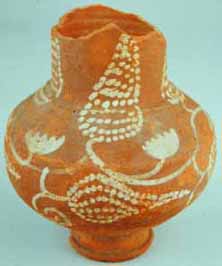 |
Jug with grapevine decoration
KM 20023
3rd to mid-4th c AD
Karanis, Egypt |
This household jug was used for pouring water, wine, or a mix of the two.
People of all ages and social statuses drank wine in the ancient world,
making wine-bibbing then much more common than in our own society. The importance
of the products of the vine is underlined by the jug's painted decoration.
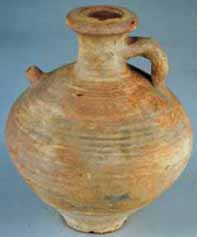 |
Spouted jar with filter
KM 8082
2nd-5th c AD
Karanis, Egypt |
Filtered water jars were designed to keep unwanted elements out of water
indended for drinking or cooking. In this case, the filter (at the base
of the neck of the pot) is quite simple, but some filters could be quite
decorative. A much smaller
filtered jar could be used to fill oil lamps.
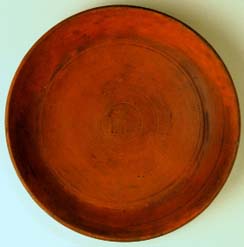 |
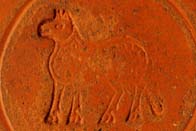 |
African Red Slip Vessel with Stamped Decoration
KM 7167
6th c AD
Karanis, Egypt |
Lamb
Center detail of KM 7167 |
When this large shallow dish was first accessioned by the Kelsey Museum,
it was labelled a 'culinary mixing bowl', but it was more probably used
to serve cooked food. The lamb symbol stamped inside may be evidence of
the spread of Christianity into Egypt, invoking the 'Lamb of God' imagery
used by early Christians. Compare this platter with the fragment of another
dish from Karanis.
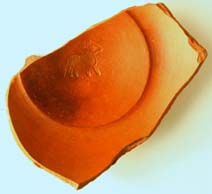 |
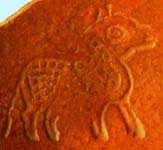
|
African Red Slip Vessel with Stamped Decoration
KM 20978
5th-6th c. AD
Karanis, Egypt |
Lamb
Center detail of KM 20978 |
This bowl is an import to Karanis, coming from production centers further
west on the North African coast. African red-slip ware was considered 'fine'
tableware, and in some households it would have been used only on special
occasions. By contrast, the coarser jugs (such as the two shown above) were made locally and used frequently, probably for transporting,
storing and serving liquids. This type of imported dinnerware would have
been more expensive than the local coarsewares represented in the domestic assemblage.
Glass
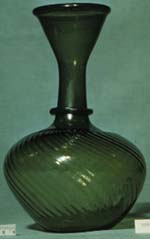 |
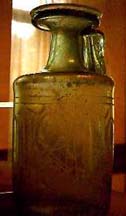
|
Glass flask
KM 5944
3rd-4th c AD
Karanis, Egypt |
Glass jug with wheel-cut decoration
KM 5947
4th c AD
Karanis, Egypt |
The flask and bottle-jug (volume approximately 1.2 and 1.6 liters respectively)
were formed using a technique known as free-blowing and colored with metallic
oxides. Found in a carefully concealed pottery jar in a house courtyard
along with several other complete glass vessels (view a
photo of the discovery of a different cache of glass), they were probably
for domestic use - as tableware for holding wine, oil, or other liquids.
Blown glass vessels were highly prized and often passed on from generation
to generation.
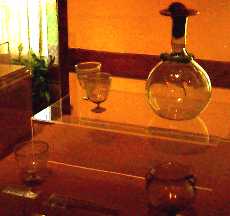 |
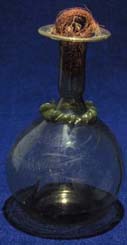 |
Four cups and flask
KM 5551; 5950; 5065; 5966; 5936
4th or 5th c. AD
Karanis, Egypt |
Close view of KM 5936 |
These five pieces of glass represent several different hoards of glass from
Karanis. The flask and glasses are delicately decorated, suggesting that
they may have been used for special occasions. The flask, which has a palm-fiber
stopper, was discovered with a reddish residue inside. Perhaps it was last
used to serve wine.
Explore the Kelsey Museum's wide-ranging collection of food-related artifacts
in More Food for Thought.
Visit another Kelsey Museum exhibit, "Wondrous
Glass," which showcases the Kelsey's extensive holdings of ancient
glass from Karanis and elsewhere in the Roman empire.
See more images
of glassware and other objects from Karanis.
